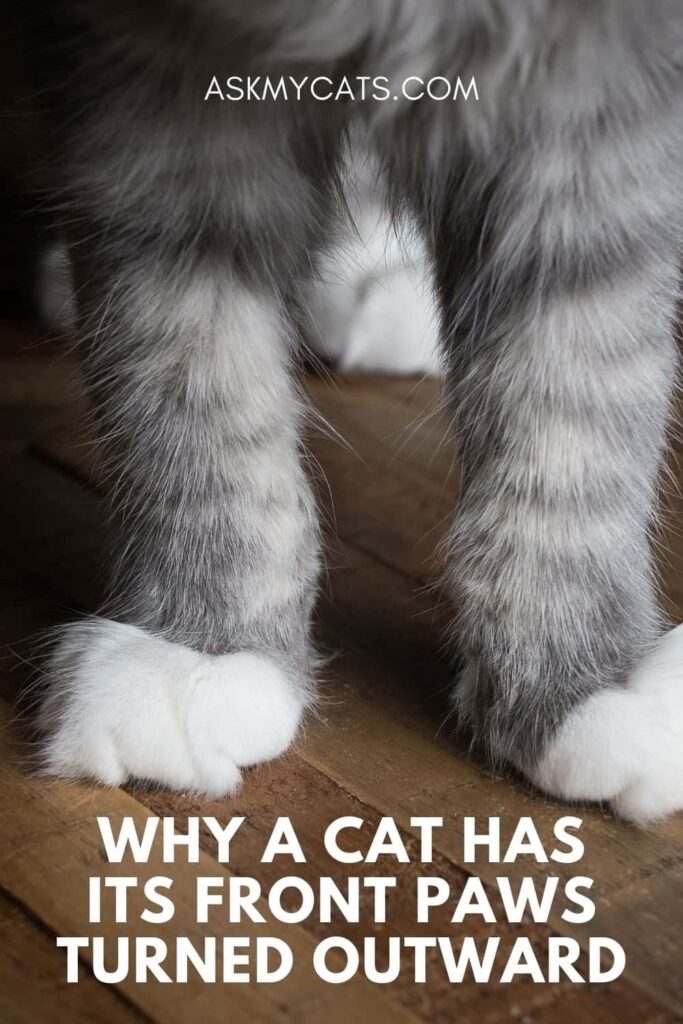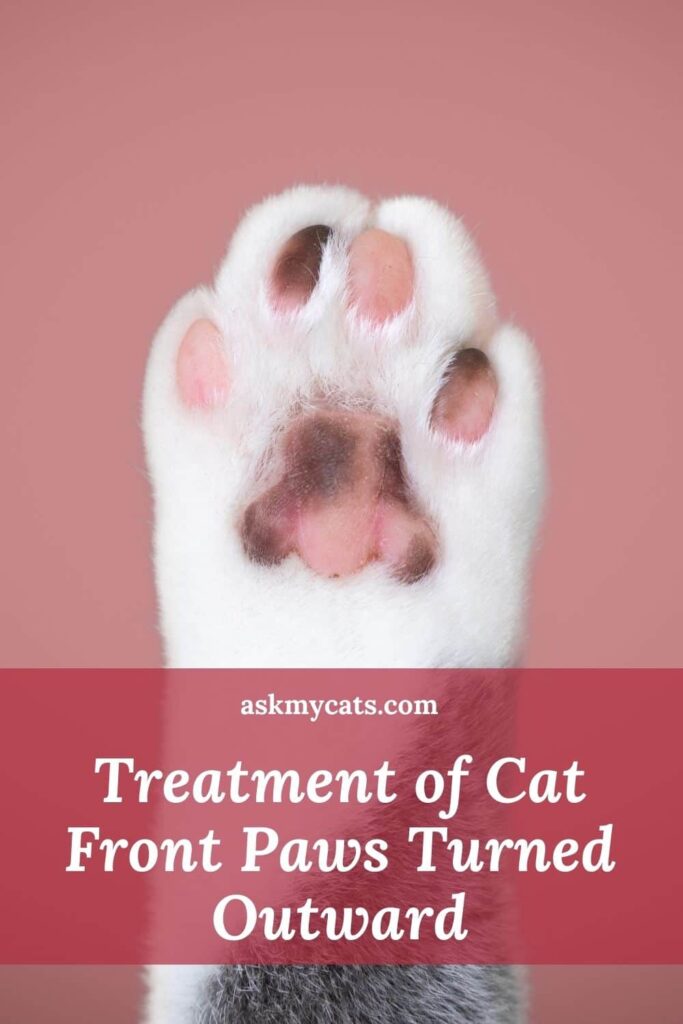You may notice that you cat’s front paws may be turned outward. This is basically called angular limb deformities.
This is the term used to characterize bone-form anomalies from the normal.
Angular deformations of the leg can be congenital or developmental in cats.
There are congenital deformations at birth, while deformations in development occur between four and eight months of age during the feline growth period.
Cat’s paws may be turned outward due to several reasons like fall, Hit-by-car, being dropped or being stepped on. It may also be due to hereditary malformation or genetic disorders.


Give Your Cat the Perfect Day
Get the Free Ebook!
Why A Cat Has Its Front Paws Turned Outward: Top Reasons

1. Irregularity In Growth
Deformities in the angular limb are a product of defects in the growth plates responsible for bone growth as the feline matures.
The growth plates are fragile and do not fuse after one year of age, so angular limb deformities will result from injuries or dietary experiences until the feline completes one year.
Have you ever crated you cat at night? Can it be harmful for them? Read here.
2. Abnormality?
An excessive bone development that has resulted in irregularly developed or bent limbs is angular limb deformity in cats.
Deformities of the angular limb may be present at the time of birth or occur during the growth phase of the cat’s development.
The forelimbs, since they are made up of two long bones, are the most prominent region to be affected by angular limb deformities, but the rear limbs may also be affected.
A prevalent bowing of the knees, either inward or outward, can be observed by cat owners.
There will be no problems for certain felines with angular limb deformities, while others experience clinical symptoms of limping, discomfort, and the failure to perform some activities.
3. Gene Talks
Deformities of the angular limb can result from a hereditary predisposition to premature closing of the growth plate, damage to the active growth plate (resulting in premature closure), or a fracture of the malunion.
This is a consequence of the genetic abnormalities which give their distinctive appearance to these breeds.
The most frequently found angular limb deformities observed in these breeds are premature closing of the distal ulnar physis and premature closure of the medial part of the distal tibial physis.
In any animal that is not yet fully matured, trauma-induced premature growth plate closure can occur, while malunion fractures can occur in animals of any age.
Your cat may not be genetically developed presently, which can be proved by the fact that they cry like babies at night!
4. Trauma!
In cats, traumatic causes of angular extremity deformities include:
Falls, Hit-by-car, Being dropped, Being stepped on. Your cat may fall from a certain height and suffer from pain.
Your cat may experience some dangerous accident like getting hit by a car and it may cause his paws to be projected outward. Anyone may also step over his paws which is a ridiculous thing to hear!
Symptoms of Deformities in the Angular Limb in Cats
The appearance of the bones of the arms bowing away or against the feline’s midline suggests clinical symptoms of angular limb deformities in cats.
Pet owners will observe this irregularity from the front of the feline, usually involving the ulna and radius, since her standing posture will appear odd.
Many felines do not feel pain from the new deformity, while others may experience discomfort and reduced mobility.
The appearance of a bone deformity is evident on a radiograph, but pet owners may notice signs, including:
- The Pain
- Reduced motion spectrum of joints
- Limping Failure to execute (jumping, running) certain tasks
- Arthritis
Is your cat facing problems in retracting his claws? Take a look here.
Cat Front Paws Turned Outward (Angular Joint Deformities) Diagnosis in Cats
In cats, angular limb deformities affect a feline at an early age and a medical record for examination as part of the diagnostic process does not yet be established.
However, by supplying crucial knowledge that is important to the feline’s condition, cat owners can assist the veterinarian.
Informing the veterinarian about previous problems with the owners that the young cat has sustained or family illnesses is important information for you to convey to the vet.
There will be a physical assessment of the injured feline, rotating the affected paws to detect the range of motion and the presence of pain.
1. X-ray (Radiography)
The main procedure a veterinarian will use to examine a limb deformity is an x-ray.
The radiograph allows the physician to view the location, direction, and extent of the abnormality of the bone.
2. CT Scanning (Computed tomography)
After an x-ray, a CT scan is often completed, as this test provides a cross-sectional image of the affected limb (s).
In comparison with the x-ray, this 3-dimensional image will provide the veterinarian with additional information about the deformity.
Treatment of Cat Front Paws Turned Outward (Deformities of Angular Limb)
Without the need for treatment, many felines with moderate angular extremity deformities can be controlled. In cats, a mild angular limb deformity is primarily a cosmetic flaw, not followed by pain.
The veterinarian may use conservative management techniques such as weight management and prevention of intense exercise to treat these cases.
In order to reduce unnecessary stress on the joints, prevent injury and arthritis later in the life of the cat, a conservative management method is set in place.

Cats with severe deformities of the angular limb may require surgical correction and are referred to a specialist often. The placement of skeletal fixators to straighten the bone and keep them aligned requires surgical correction of an angular limb deformity.
If your cat is suffering severely from angular limb deformities, surgical correction of angular limb deformities in cats has potential risks that your veterinarian will discuss with you.
In order to cure the bones following corrective surgery, the animal may have rest and exercise limits for 4 to 8 weeks.
Your surgeon will also need to re-check your symptoms and locate and correct them as quickly as possible.
To track improvement and determine the effectiveness of the remedial surgery, X-rays must be re-checked.
They are often necessary to see if the bone, often cut during the correction operation, has recovered enough to permit uncontrolled intervention.
An Elizabethan collar could be required to prevent your pet from opening or infecting the incision if it chews or licks on the incision. If a bandage, splint or cast is applied on the leg then it is vital that the pet is kept clean and dry.
A soaked or chewed bandage needs to be removed as easily as possible. These are the most supporting attributes of a chewed bandage.
Check the guidance of your veterinarian diligently to achieve the best results. Get your doctor inspect him, if you own a small, developing pet and him gets hurt.
Compare the time and straightness of the unimpacted and damaged leg and, if you find any discrepancies, contact the vet as soon as possible.
Recovery of Cats Front Paws Turned Outward (Angular Limb Deformity)

A relatively positive end result is the prognosis for cats that are managed conservatively for their corner limb distortions.
The main aim for the management of the deformity of an angular extremity is to reduce joint stress, and veterinary instructions must therefore be followed.
Felines that have undergone surgery will frequently be reassessed so that bones don’t continue to twist and cure properly.
If the length of the injured leg varies significantly from that of the opposite leg, a bone expansion technique called osteogenesis of distraction should be used.
This includes using an external fixator that can enclose metal rings and bars across the knee.
The bone ends are slowly removed by the owner’s turn of a knob or an outlet two days a day over a period of weeks or months. Knob fills over the fibrous tissues, and substantial gains in duration can be made during the distraction process.
Abnormal forces on the joints can contribute to long-term arthritis. Arthritis can take the form of pain relievers and weight control and need medical treatment; seek advice from your vet before your animal receives pain relievers.
The extreme joint trauma can require operational fusion in order to eradicate the pain source.
Frequently Asked Questions
What is knuckling in cats?
Place the dorsal surface of the paw on the table (knuckle test) – substitute it immediately at the usual spot. Nevertheless, most cats are sensitive and excessively withdraw. Position tactile / visual instead.
What does it mean when a cat extends its paws?
A cat is going to stretch its paws to a variety of various things, such as kneeling. When they’re happy, they could put out their hands, stretch their nails, and then draw them in a pattern, which is how they get their mother’s milk to flow. A cat may even stretch its paws in rage or terror.
Is carpal hyperextension in cats painful?
Hyperextension can be secondary to polyarthropathy or autoimmune illness. Signs: a) acute injury-pain, non-weight-bearing lameness, soft tissue swelling; b) chronic or degenerative injuries-often relatively painless, irregular, hyper-extended joint stance when weight-bearing.
What causes knuckling in cats?
Femoral nerve injury results in a nudging and lack of sensation in the dorsal limb and in an inability to flex the stifle and the snout. Tibial neuropathy results in a lowered snout and reduced snout extension. The typical abnormality of the gait seen in the cat is that of the snout.
Final Words
Angular limb deformities are dynamic issues needing committed and conscientious owners.
So how did you cope up with your cat that had his front paws bend outwards?
What extra care was needed for his recovery?
Do let us know in the comments section below!
